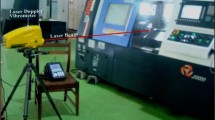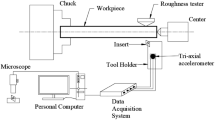Abstract
The abrupt changes in tool-workpiece interaction during machining process induce variation in the surface quality of work material. These interactions include built-up edge formation and their break-off, environmental conditions (use of coolant, rise of temperature etc.), material imperfections, improper structural fitness of machine & tool components, etc. This study presents prediction of surface roughness in turning of EN353 steel implementing the variational mode decomposition (VMD) for processing the vibration data, followed by estimation of the surface roughness using the relevance vector regression (RVR) optimized by particle swarm optimization (PSO). The raw vibration data has been decomposed in five discrete sets of frequency components known as variational mode functions (VMFs). A set of twenty-one statistical features in each three axes have been extracted for raw data and each VMF. The RVR has been trained using these 21×3 = 63 features and 3 cutting parameters — cutting speed, feed depth of cut. The RVR has also been trained separately using top 5 features selected through RreliefF algorithm. The optimal decomposition level has been determined to minimize the noise and predict the surface finish accurately. The results obtained in 1st VMF (high frequency, low amplitude) using its top 5 features for prediction have been found to be reliable with higher prediction accuracy.
Similar content being viewed by others
References
C. L. He, W. J. Zong and J. J. Zhang, Influencing factors and theoretical modeling methods of surface roughness in turning process: state-of-the-art, Int. J. Mach. Tools Manuf., 129 (2018) 15–26.
E. D. Kirby, J. C. Chen and J. Z. Zhang, Development of a fuzzy-nets-based in-process surface roughness adaptive control system in turning operations, Expert Syst. Appl., 30(4) (2006) 592–604.
S. V. Prasad, B. V. R. R. Kumar and V. V. S. Rao, Prediction of surface roughness in turning of EN19 steel using acoustic emission, Recent Adv. Mater. Sci., Springer Singapore, Singapore (2019) 113–122.
C. Beggan et al., Using acoustic emission to predict surface quality, Int. J. Adv. Manuf. Technol., 15(10) (1999) 737–742.
D. R. Salgado et al., In-process surface roughness prediction system using cutting vibrations in turning, Int. J. Adv. Manuf. Technol., 43(1–2) (2009) 40–51.
E. G. Plaza and P. J. N. Lopez, Surface roughness monitoring by singular spectrum analysis of vibration signals, Mech. Syst. Signal Process, 84 (2017) 516–530.
E. G. Plaza and P. J. N. López, Application of the wavelet packet transform to vibration signals for surface roughness monitoring in CNC turning operations, Mech. Syst. Signal Process, 98 (2018) 902–919.
B. Samanta, Surface roughness prediction in machining using soft computing, Int. J. Comput. Integr. Manuf., 22(3) (2009) 257–266.
V. Upadhyay, P. K. Jain and N. K. Mehta, In-process prediction of surface roughness in turning of Ti-6Al-4V alloy using cutting parameters and vibration signals, Meas. J. Int. Meas. Confed., 46(1) (2013) 154–160.
Z. Hessainia et al., On the prediction of surface roughness in the hard turning based on cutting parameters and tool vibrations, Meas. J. Int. Meas. Confed., 46(5) (2013) 1671–1681.
E. G. Plaza and P. J. N. López, Analysis of cutting force signals by wavelet packet transform for surface roughness monitoring in CNC turning, Mech. Syst. Signal Process, 98 (2018) 634–651.
K. A. Risbood, U. S. Dixit and A. D. Sahasrabudhe, Prediction of surface roughness and dimensional deviation by measuring cutting forces and vibrations in turning process, J. Mater. Process. Technol., 132(1–3) (2003) 203–214.
N. Xie, J. Zhou and B. Zheng, An energy-based modeling and prediction approach for surface roughness in turning, Int. J. Adv. Manuf. Technol., 96(5–8) (2018) 2293–2306.
M. Pour, Determining surface roughness of machining process types using a hybrid algorithm based on time series analysis and wavelet transform, Int. J. Adv. Manuf. Technol., 97(5–8) (2018) 2603–2619.
H. H. Shahabi and M. M. Ratnam, Prediction of surface roughness and dimensional deviation of workpiece in turning: a machine vision approach, Int. J. Adv. Manuf. Technol., 48(1–4) (2010) 213–226.
M. S. Chen and S. W. Wang, Fuzzy clustering analysis for optimizing fuzzy membership functions, Fuzzy Sets Syst., 103(2) (1999) 239–254.
W. Duch, R. Adamczak and K. Grąbczewski, A new methodology of extraction, optimization and application of crisp and fuzzy logical rules, IEEE Trans. Neural Networks, 12(2) (2001) 277–306.
Y. V. Deshpande, A. B. Andhare and P. M. Padole, Application of ANN to estimate surface roughness using cutting parameters, force, sound and vibration in turning of Inconel 718, SN Appl. Sci., 1(1) (2019) 1–9.
V. Guleria, V. Kumar and P. K. Singh, Classification of surface roughness during turning of forged EN8 steel using vibration signal processing and support vector machine, Eng. Res. Express, 4(1) (2022) 015029.
S. Chauhan, M. Singh and A. K. Aggarwal, Bearing defect identification via evolutionary algorithm with adaptive wavelet mutation strategy, Meas. J. Int. Meas. Confed., 179 (2021) 109445.
S. Chauhan, M. Singh and A. K. Aggarwal, An effective health indicator for bearing using corrected conditional entropy through diversity-driven multi-parent evolutionary algorithm, Struct. Heal. Monit. (2020) (online first).
W. A. Woyczyński, Uncertainty principle and wavelet transforms, A First Course Stat. Signal Anal. (2019) 57–90.
K. He, Q. Xu and M. Jia, Modeling and predicting surface roughness in hard turning using a bayesian inference-based HMM-SVM model, IEEE Trans. Autom. Sci. Eng., 12(3) (2015) 1092–1103.
G. Vashishtha and R. Kumar, An amended grey wolf optimization with mutation strategy to diagnose bucket defects in Pelton wheel, Measurement, 187 (2022) 110272.
G. Vashishtha and R. Kumar, Pelton wheel bucket fault diagnosis using improved shannon entropy and expectation maximization principal component analysis, J. Vib. Eng. Technol., 10 (2022) 335–349.
B. Bhardwaj, R. Kumar and P. K. Singh, Prediction of surface roughness in turning of EN 353 using response surface methodology, Trans. Indian Inst. Met., 67(3) (2014) 305–313.
A. Kumar et al., Adaptive sensitive frequency band selection for VMD to identify defective components of an axial piston pump, Chinese J. Aeronaut., 35(1) (2022) 250–265.
G. Vashishtha and R. Kumar, An effective health indicator for the pelton wheel using a levy flight mutated genetic algorithm, Meas. Sci. Technol., 32(9) (2021) 094003.
K. Dragomiretskiy and D. Zosso, Variational mode decomposition, IEEE Trans. Signal Process, 62(3) (2014) 531–544.
R. J. Urbanowicz et al., Relief-based feature selection: introduction and review, J. Biomed. Inform., 85 (2018) 189–203.
K. Kira and L. A. Rendell, The feature selection problem: traditional methods and a new algorithm, Proc. Tenth Natl. Conf. Artif. Intell., San Jose (1992) 129–134.
I. Kononenko, Estimating attributes: analysis and extensions of RELIEF, Lect. Notes Comput. Sci. (1994) 171–182.
M. Robnik-Šikonja and I. Kononenko, An adaptation of relief for attribute estimation in regression, Mach. Learn. Proc. Fourteenth Int. Conf., 5 (1997) 296–304.
M. E. Tipping, The relevance vector machine, Adv. Neural Inf. Process. Syst. (2000) 653–658.
H. Fattahi and M. Hasanipanah, Prediction of blast-induced ground vibration in a mine using relevance vector regression optimized by metaheuristic algorithms, Nat. Resour. Res., 30 (2021) 1849–1863.
S. W. Fei, The hybrid model of empirical wavelet transform and relevance vector regression for monthly wind speed prediction, Int. J. Green Energy, 17(10) (2020) 583–590.
D. Kong et al., Relevance vector machine for tool wear prediction, Mech. Syst. Signal Process, 127 (2019) 573–594.
S. Kiranyaz, Particle swarm optimization, Adapt. Learn. Optim., 15 (2014) 45–82.
C. P. Jesuthanam, S. Kumanan and P. Asokan, Surface roughness prediction using hybrid neural networks, Mach. Sci. Technol., 11(2) (2007) 271–286.
S. Tamang and M. Chandrasekaran, Integrated optimization methodology for intelligent machining of Inconel 825 and its shop-floor application, J. Brazilian Soc. Mech. Sci. Eng., 39(3) (2017) 865–877.
M. K. Gupta, P. K. Sood and V. S. Sharma, Machining parameters optimization of titanium alloy using response surface methodology and particle swarm optimization under minimum-quantity lubrication environment, Mater. Manuf. Process, 31(13) (2016) 1671–1682.
L. J. Song et al., A dynamic multi-swarm particle swarm optimizer for multi-objective optimization of machining operations considering efficiency and energy consumption, Energies, 13(10) (2020) 2616.
S. Chauhan, G. Vashishtha and A. Kumar, A symbiosis of arithmetic optimizer with slime mould algorithm for improving global optimization and conventional design problem, J. Supercomput., 78 (2022) 6234–6274.
S. Chauhan and G. Vashishtha, Mutation-based arithmetic optimization algorithm for global optimization, 2021 Int. Conf. Intell. Technol. (2021) 1–6.
S. C. Lin and M. F. Chang, A study on the effects of vibrations on the surface finish using a surface topography simulation model for turning, Int. J. Mach. Tools Manuf., 38(7) (1998) 763–782.
X. Wang et al., Predictive modeling of surface roughness in lenses precision turning using regression and support vector machines, Int. J. Adv. Manuf. Technol., 87(5–8) (2016) 1273–1281.
H. Wang et al., A theoretical and experimental investigation of the tool-tip vibration and its influence upon surface generation in single-point diamond turning, Int. J. Mach. Tools Manuf., 50(3) (2010) 241–252.
Author information
Authors and Affiliations
Corresponding author
Additional information
Vikrant Guleria received the B.Tech. in Mechanical Engineering from Himachal Pradesh University, Shimla, India, in 2010, and the M.E. in Manufacturing Technology from the National Institute of Technical Teachers Training and Research, Chandigarh, India, in 2017. He is currently pursuing the Ph.D. from Sant Longowal Institute of Engineering and Technology, Longowal, India. Mr. Guleria has around 6 years of professional experience in teaching and industry. His current research interests include signal processing, condition monitoring, vibration analysis, machine learning, and conventional machining processes.
Vivek Kumar is an Assistant Professor in the Department of Mechanical Engineering, Sant Longowal Institute of Engineering and Technology, Sangrur, India. He obtained his Ph.D. in the Mechanical Engineering in field of railway dynamics. Dr. Kumar has around 15 years of professional experience in teaching and research. His research interest includes Rail and vehicle dynamics, structural dynamics, metal machining, fault diagnosis & Vibration analysis.
Pradeep Kumar Singh is a Professor of Mechanical Engineering, at Sant Longowal Institute of Engineering & Technology, Longowal. He has also served Encardio-rite Electronics (P) Ltd., Lucknow, and Scooters India Ltd., Lucknow for a small span of time. He received B. Tech. in Mechanical Engineering from the Institute of Engineering & Technology (IET), Lucknow, in 1990, M. Tech. in Mechanical Engineering (specialization in Production Engineering) from the Institute of Technology, Banaras Hindu University (IT-BHU, now IIT), Varanasi, in 1992, and Ph.D. in Mechanical Engineering from the Indian Institute of Technology (IIT), Roorkee, in 2005. Dr. Singh has about 30-year of professional experience in teaching, industry and research. He is an Associate Editor of the “Insight Mechanical Engineering”, and has been the guest editor to International Journal of Applied Engineering Research, and International Journal of Engineering Studies, in the past. His research interests include tolerance design, metal machining, advanced optimization and modeling & simulation of mechanical systems, waste management & energy recovery, aluminum composites, polymer composites, etc.
Rights and permissions
About this article
Cite this article
Guleria, V., Kumar, V. & Singh, P.K. A novel approach for prediction of surface roughness in turning of EN353 steel by RVR-PSO using selected features of VMD along with cutting parameters. J Mech Sci Technol 36, 2775–2785 (2022). https://doi.org/10.1007/s12206-022-0510-2
Received:
Revised:
Accepted:
Published:
Issue Date:
DOI: https://doi.org/10.1007/s12206-022-0510-2




